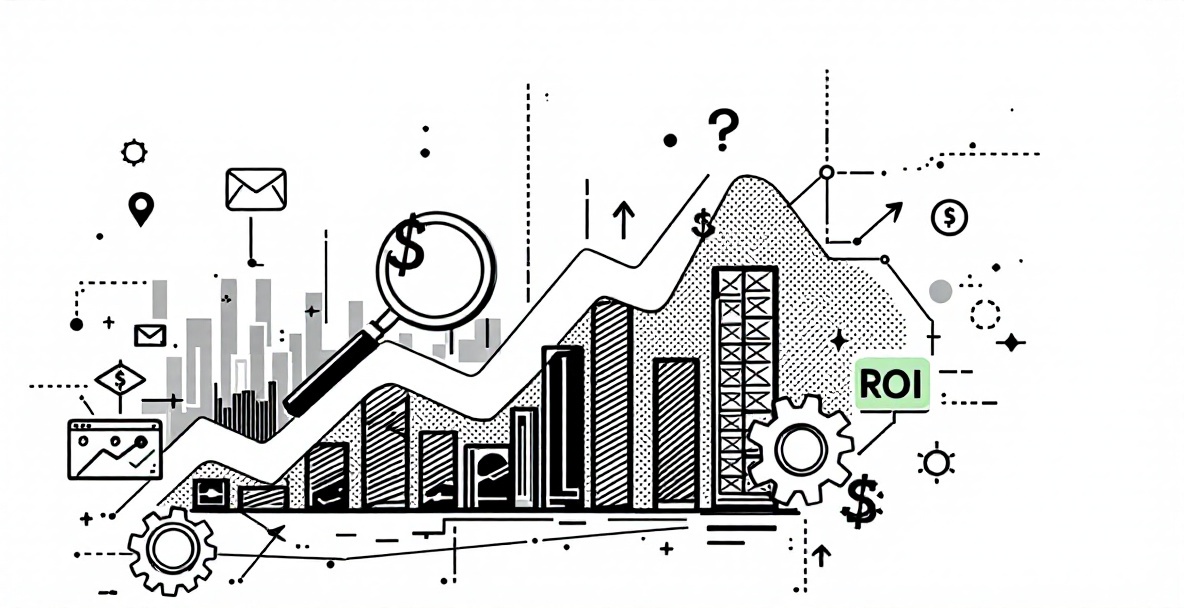In the competitive landscape of digital marketing, understanding the return on investment (ROI) of your content efforts isn't just beneficial—it's essential for survival. As marketing budgets face increasing scrutiny, the ability to quantify and communicate the value of content initiatives has become a critical skill for marketers who want to secure resources and demonstrate their strategic contribution to business objectives.
Understanding Content ROI: The Foundation of Data-Driven Marketing

Content ROI represents the measurable financial return generated from your content marketing investments. It transforms content from a creative endeavor into a strategic business asset with quantifiable outcomes. When properly calculated, content ROI helps marketers justify budgets, optimize resource allocation, and identify the most effective content types for their unique business goals.
The Challenge of Content Marketing Measurement
Content marketing presents unique measurement challenges that don't exist in more straightforward marketing channels. Traditional ROI calculations struggle with content's complex, multi-touch influence on customer journeys. Content often serves multiple purposes simultaneously—building awareness, nurturing leads, supporting sales, and reinforcing loyalty—making attribution particularly difficult.
The extended timeframes of content performance add another layer of complexity. Unlike paid advertising with immediate results, high-quality content can continue generating value for years, creating a compounding return that's challenging to capture in standard measurement frameworks. This long-term value generation means that focusing solely on short-term metrics can severely undervalue content's true contribution.
Additionally, measuring indirect benefits like brand authority and audience trust requires sophisticated approaches beyond basic analytics. These intangible assets significantly impact business performance but resist simple quantification, requiring marketers to develop nuanced measurement strategies that capture both direct and indirect value creation.
Key Performance Indicators for Content Marketing
Effective content ROI measurement begins with selecting appropriate KPIs aligned with specific business objectives. For awareness-focused content, metrics like reach, impressions, and brand search volume provide valuable insights. Engagement-oriented content benefits from metrics such as time on page, scroll depth, and social shares, which indicate audience interest and content resonance.
For conversion-focused content, lead generation metrics, form completions, and sales inquiries become central KPIs. Revenue-oriented measurement tracks content-influenced purchases, average order value, and customer lifetime value attribution. Each of these metric categories serves different strategic purposes and should be weighted according to your specific marketing goals.
Advanced content marketing programs also incorporate customer retention and loyalty metrics, measuring how content influences repeat purchases, subscription renewals, and referral generation. By establishing a balanced scorecard of KPIs across the customer journey, marketers can develop a comprehensive understanding of content's multifaceted business impact.
Setting Up Your Measurement Infrastructure

Creating a robust measurement foundation is essential for accurate content ROI calculation. Without proper tracking systems, even the most sophisticated analysis will yield flawed results.
Google Analytics Dashboard Configuration
Google Analytics remains the cornerstone of content performance measurement when properly configured. Beyond basic installation, effective content ROI tracking requires custom dashboard setups that align with your specific business goals. Create dedicated content performance dashboards that segment traffic by content types, topics, and formats to identify patterns in visitor behavior.
Configure conversion goals that track micro-conversions like newsletter signups alongside macro-conversions such as purchases or lead submissions. Implement event tracking to capture engagement actions that indicate content quality, such as video views, download completions, and scroll depth milestones. These granular insights reveal how visitors interact with your content before converting.
Advanced users should implement enhanced ecommerce tracking to connect content consumption directly to revenue generation. This powerful feature allows you to see which content pieces influence purchases and their economic value throughout the customer journey. When combined with user segment analysis, these insights help identify which content types deliver the highest ROI for specific audience segments.
Technical SEO Audit Implementation
Technical SEO forms the foundation of content discoverability and performance. Implementing a comprehensive technical SEO audit checklist ensures your content can be properly indexed, crawled, and ranked. Regular audits identify issues like slow loading speeds, mobile rendering problems, and crawl errors that can severely impact content performance and ROI.
At SEO Tuts, we've found that technical barriers often prevent otherwise excellent content from reaching its potential audience. Our technical SEO audit process examines critical factors including site architecture, URL structure, schema markup implementation, and core web vitals performance. By addressing these technical fundamentals, marketers can significantly improve content visibility and engagement metrics.
The audit process should also evaluate content accessibility across devices and platforms. As mobile continues to dominate content consumption, ensuring responsive design and accelerated mobile page compatibility becomes increasingly important for maximizing content reach and effectiveness.
Integration with Marketing Automation
Sophisticated content ROI measurement requires connecting content interactions to your broader marketing ecosystem. Marketing automation integration creates the necessary infrastructure to track how content consumption influences lead qualification, nurturing progression, and conversion propensity.
Configure your marketing automation platform to capture content engagement signals and incorporate them into lead scoring models. This approach helps quantify how specific content types contribute to moving prospects through your sales funnel. By assigning point values to different content interactions, you can measure each piece's contribution to lead qualification.
The real power emerges when you integrate CRM data with content analytics. This connection allows you to trace closed revenue back to initial content touchpoints, creating a complete picture of content's role in revenue generation. Implement UTM parameters consistently across your content distribution channels to maintain attribution clarity throughout the customer journey.
Content Performance Metrics and ROI Calculation

After establishing your measurement infrastructure, the next step involves analyzing performance data and calculating actual ROI values.
Traffic and Engagement Metrics
Traffic metrics provide the foundation for content performance analysis but require contextual interpretation. Rather than focusing solely on overall traffic volume, segment visitors by source, device, and behavior patterns to identify high-value audience segments. Analyze traffic quality indicators like bounce rate, pages per session, and new versus returning visitor ratios to evaluate audience relevance.
Engagement metrics reveal how effectively your content resonates with visitors. Average session duration and scroll depth percentages indicate content consumption levels, while interaction rates with embedded elements like videos or calculators demonstrate active engagement. Social sharing and comment activity serve as proxies for content value and relevance to your audience.
The most valuable traffic analysis examines content consumption patterns over time. Identifying which pieces maintain consistent traffic versus those with short-lived spikes helps you understand your content's longevity and sustained value generation potential. This temporal analysis is crucial for accurate ROI calculation, as it captures the compounding returns high-quality content delivers.
Conversion Tracking and Attribution
Conversion tracking connects content consumption to business outcomes by following visitor paths from initial content engagement to valuable actions. Implement first-party cookies (respecting privacy regulations) to maintain visitor identity across sessions, allowing you to attribute conversions to content touchpoints even when they occur days or weeks apart.
Multi-touch attribution models provide more sophisticated insights than last-click attribution by distributing conversion credit across multiple content interactions. Linear attribution assigns equal value to all touchpoints, while position-based models give greater weight to first and last interactions. Time-decay models assign more credit to touchpoints closer to conversion. The most advanced marketers use algorithmic attribution that dynamically weights touchpoints based on their statistical impact on conversion probability.
Attribution should extend beyond initial conversion to capture content's influence on customer lifetime value. By continuing to track customer behavior post-conversion, you can identify which content types not only acquire customers but also contribute to higher retention rates, larger purchase values, and increased loyalty behaviors.
ROI Formula and Calculations
The fundamental content ROI formula remains straightforward: (Return – Investment) / Investment × 100 = ROI%. However, accurately determining both return and investment values requires careful analysis and some strategic decisions about attribution methods.
For investment calculations, include all costs associated with content production, distribution, and measurement. Direct costs encompass content creation expenses like writer fees, design work, video production, and editing services. Indirect costs include proportional allocations of software subscriptions, marketing team salaries, and management overhead. Distribution costs incorporate paid promotion, email marketing expenses, and social media management related to content amplification.
Return calculations should capture both direct and indirect revenue impacts. Direct returns include revenue from tracked conversions attributed to specific content pieces. Indirect returns encompass more challenging metrics like brand lift, search ranking improvements, and audience growth. While these indirect benefits resist precise quantification, they can be estimated through comparative analysis of brand metrics before and after content initiatives.
For complex content programs, calculate ROI at multiple levels: individual content pieces, topic clusters, channels, and overall program performance. This multi-level approach identifies your highest-performing content investments and reveals optimization opportunities that aggregate ROI analysis might miss.
Optimization Strategies for Maximizing Content ROI

With measurement systems established and baseline ROI calculated, optimization becomes the focus for improving return on content investments.
Content Creation and Optimization
Content optimization begins with audience alignment. Review performance data to identify which topics, formats, and styles resonate most strongly with your target audience. Look for patterns in high-performing content and replicate these elements in new content development. Pay particular attention to content that maintains consistent performance over extended periods, as these evergreen pieces typically deliver the highest lifetime ROI.
Implement structured content updating procedures to maintain relevance and performance of existing assets. Regular refreshes of top-performing content with updated information, expanded sections, and improved visuals can significantly extend content lifespan and value generation. This approach typically delivers higher ROI than continuously creating new content, as it builds upon already successful foundations.
Develop content repurposing workflows to maximize value from your investments. A single research initiative can generate multiple content assets across different formats—from in-depth guides to infographics, videos, and social snippets. This approach significantly reduces per-unit content costs while maintaining quality and expanding reach across preferences for different content consumption formats.
Link Building and Authority Development
Strategic link building amplifies content ROI by improving organic visibility and referral traffic. Focus link acquisition efforts on content assets with high conversion potential but inadequate visibility. By securing quality backlinks to these conversion-optimized pieces, you increase their traffic without compromising their existing conversion rates.
Authority building represents a long-term investment in domain strength that compounds over time. Develop thought leadership content that attracts natural links from industry publications, professional associations, and educational institutions. These high-authority backlinks not only drive referral traffic but also enhance domain credibility, improving ranking potential for all content assets.
At SEO Tuts, we've found that strategic internal linking significantly impacts content ROI with minimal additional investment. Implement topic clusters that connect related content pieces with consistent internal linking structures. This approach strengthens the topical authority of your most valuable content assets while creating natural pathways for visitors to encounter conversion-optimized pages.
Conversion Rate Optimization
Systematic CRO represents one of the highest-leverage activities for improving content ROI. Small improvements in conversion rates multiply the value of existing traffic, immediately enhancing return without additional investment. Implement A/B testing programs for key conversion elements like call-to-action placements, form designs, and content layouts.
Review user flow analytics to identify content-specific conversion barriers. High exit rates on particular sections often indicate confusion, credibility issues, or misaligned expectations that can be addressed through targeted revisions. Similarly, analyze form abandonment patterns to uncover friction points in your conversion process that may be undermining otherwise effective content.
Enhanced personalization can significantly improve content conversion rates by delivering more relevant experiences. Implement conditional content sections that adapt based on visitor characteristics like industry, role, or previous site behavior. This approach increases content relevance for specific audience segments, improving engagement and conversion probability without creating entirely new content assets.
Advanced ROI Enhancement Techniques
For marketers seeking to further elevate their content ROI, several advanced approaches can deliver substantial improvements.
Customer Journey Analysis
Comprehensive customer journey mapping reveals how content influences buying decisions across the entire relationship lifecycle. This analysis identifies critical content touchpoints that disproportionately impact conversion likelihood, allowing for targeted optimization of these high-leverage moments. By understanding exactly when and how content influences decisions, marketers can focus investments where they deliver maximum impact.
Journey analysis also uncovers content gaps that may be causing prospect leakage from your funnel. Look for stages with high drop-off rates and develop targeted content to address the information needs or objections that occur at these points. This gap-filling approach often yields significant ROI improvements by recovering prospects who might otherwise abandon their buying journey.
Advanced journey mapping incorporates competitive content analysis to identify differentiating opportunities. Examine how competitors address similar customer journey stages and look for unmet information needs or quality gaps you can exploit. By developing superior content for critical decision points, you can improve both conversion rates and competitive win rates simultaneously.
Competitive Analysis and Benchmarking
Effective benchmarking contextualizes your content ROI within broader industry performance standards. Develop a competitive content marketing framework that regularly assesses your performance against direct competitors and industry leaders. This analysis should examine content volume, quality, engagement metrics, and estimated conversion effectiveness to identify relative strengths and opportunities.
Performance gap analysis pinpoints specific areas where competitor content outperforms yours, revealing targeted improvement opportunities. Examine competitors' highest-performing content to understand which topics, formats, and distribution channels drive their success. This analysis often reveals untapped opportunities or audience preferences you might otherwise overlook.
Benchmarking should extend beyond direct competitors to include content marketing leaders in adjacent industries. These cross-industry comparisons frequently uncover innovative approaches and tactics that haven't yet been widely adopted in your sector, providing first-mover advantages and differentiation opportunities.
Budget Allocation and Scaling
Data-driven budget allocation optimizes content investments based on demonstrated performance. Implement zero-based budgeting approaches that require each content initiative to justify its allocation based on previous ROI or projected returns. This approach ensures resources flow to your highest-performing content types and topics rather than being distributed based on historical precedent or departmental politics.
Incremental testing provides a systematic approach to scaling content investments. Rather than making large budget shifts based on limited data, implement small experimental allocations to test promising content initiatives. Measure the performance of these test investments carefully before committing larger resources, allowing you to validate ROI projections with minimal risk.
Develop scenario planning models that project different content investment levels and their likely returns based on historical performance data. These models should incorporate diminishing returns thresholds that identify when additional investment in particular content types or channels begins to deliver reduced marginal returns. This advanced planning helps optimize budget allocation decisions and maximize overall program ROI.
Taking Action: Implementing Your ROI Measurement Strategy
Transforming content ROI concepts into operational reality requires structured implementation planning and resource allocation.
Action Plan Development
Begin implementation with a comprehensive content audit that establishes your current performance baseline. Document existing content assets, their performance metrics, and preliminary ROI estimates based on available data. This baseline assessment identifies immediate optimization opportunities and provides a foundation for measuring improvement over time.
Develop a phased implementation roadmap that prioritizes high-impact, low-complexity initiatives. Start with foundational tracking implementation and basic ROI calculations before progressing to more sophisticated measurement approaches. This incremental approach delivers early wins that build momentum and support for your measurement program while developing necessary capabilities for advanced techniques.
Create clear measurement objectives that define what success looks like for your content ROI initiative. These objectives should include both process metrics (like tracking implementation completeness) and outcome metrics (like ROI improvement targets). Establish regular review cycles to assess progress against these objectives and adjust your implementation approach based on emerging insights.
Resource Allocation and Tools
Effective content ROI measurement requires appropriate resource allocation across people, processes, and technology. Conduct a skills assessment of your current team to identify capability gaps in analytics, data interpretation, or technical implementation. Develop training plans or consider specialized hires to address critical skill shortages that might otherwise limit your measurement effectiveness.
Select measurement tools that align with your specific needs and technical capabilities. While enterprise-level solutions offer comprehensive features, they often require significant implementation resources and technical expertise. For many organizations, starting with accessible tools like Google Analytics 4, basic CRM integration, and spreadsheet-based ROI calculations provides a more realistic entry point that can be expanded as capabilities mature.
At SEO Tuts, we've helped numerous organizations implement right-sized measurement approaches that balance sophistication with practical implementation constraints. Our experience shows that successful content ROI programs start with clear business alignment, implement foundational tracking correctly, and build measurement sophistication incrementally as they demonstrate value.
The journey to effective content ROI measurement takes time and persistence, but the competitive advantages it creates are substantial. By implementing these approaches, you'll transform content from a cost center into a strategic asset with demonstrable business impact.
Ready to transform your content marketing into a measurable business asset? Visit SEO Tuts today to access our comprehensive guides on technical SEO audits, content ROI measurement, and data-driven marketing strategies that deliver measurable results.
Leave a Reply